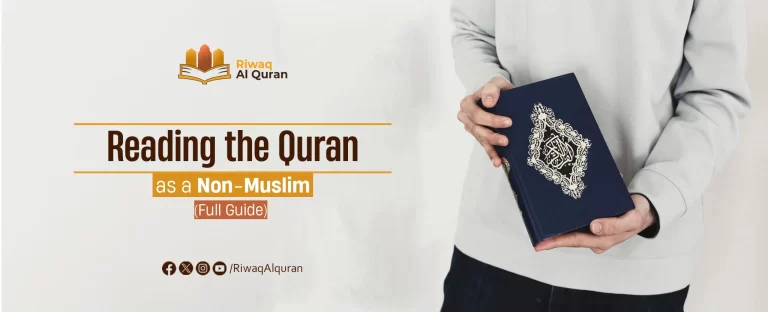In Tajweed, Ikhfaa is one of the rules of Noon Sakinah and Tanween. It is a middle case between Idgham and Izhar. Ikhfaa is to hide the whole of a letter sound or some of it while you are pronouncing it. There are 2 main types of Ikhfaa: Ikhfaa Haqiqi (الإخفاء الحقيقي) And Ikhfaa Shafawi (الإخفاء الشفوي). In this article, we will explore Ikhfaa Shafawi in more detail.
Below, we will examine the meaning, the letter(s), and Ghunnah of Ikhfaa Shafawi. We will also examine why it is called Ikhfaa Shafawi and what makes it Ikhfaa Shafawi. Then, we will explain how Ikhfaa Shafawi is pronounced and will give some examples of it from the Quran. We will also demonstrate the differences and similarities between Ikhfaa Shafawi and Ikhfaa Haqiqi on one hand and Ikhfaa Shafawi and Idgham Shafawi on the other.
Table of Contents
What Is Ikhfaa Shafawi?
Ikhfaa Shafawi is Ikhfaa made by the lips. It has to do with Meem Sakinah only. It is to conceal some of the sound of Meem Sakinah (م), keeping the Ghunnah, ONLY if Meem Sakinah (م) is followed by the letter Baa (ب). No Ikhfaa Shafawi is made in one word, so it only takes place in 2 words: the first ends with Meem Sakinah and the second starts with Baa.
Ikhfaa Shafawi Letters
Ikhfaa Shafawi occurs with only one letter. This is the letter Baa (ب). This Baa needs to have Harakah: Fatha (َ), Damma (ُ) or Kasra (ِ). If Meem Sakinah is followed by the letter Baa (ب), Ikhfaa Shafawi must be implemented.
For Example:
“تَرْمِيهِم بِحِجَارَةٍۢ مِّن سِجِّيلٍۢ”
The letter Baa “ب” in “بحجارة” hides some of the Meem (م) sound in “ترميهم” [the last Meem “م” in the word] while keeping the Ghunnah.
The Ghunnah Of Ikhfaa Shafawi
Ghunnah is a nasal sound that is produced when someone utters the sound of the letter Noon (ن) or the letter Meem (م) from the nose for approximately two seconds [i.e. 2 Harakat (one Haraka is equal to one finger count)]. In Ikhfaa Shafawi, the Ghunnah is kept.


Why Is Ikhfaa Shafawi Named By That Name?
It is called Ikhfaa Shafawi [hiding made by the lips] because:
1- Some of the sound of the letter Meem is hidden inside the letter Baa. That’s why it is called Ikhfaa.
2- The place of articulation of the Arabic letter “Meem” (م) and the Arabic letter “Baa” (ب) is the same. They are both pronounced by the lips. That’s why it is called Shafawi (by the lips).
What Makes The Ikhfaa Shafawi?
Ikhfaa (hiding the sound) is made Shafawi (by the lips) when the Baa sound comes after Meem Sakinah. So this hiding becomes Shafawi as it is produced by the lips for the two sounds: Meem and Baa.
How To Pronounce Ikhfaa Shafawi?
There are two ways to pronounce Ikhfaa Shafawi. The first one is more common. Let’s explore them below:
1- Close the lips completely and keep the nasal sound (Ghunnah) for 2 Harakat.
2- Close the lips, leaving a small gap between them, and keep the nasal sound (Ghunnah) for 2 Harakat.
Ikhfaa Shafawi Examples In the Quran
There are so many examples of Ikhfaa Shafawi in the Quran. Please see below four (4) examples of it with a global explanation.
“قَالَ يَـٰٓـَٔادَمُ أَنۢبِئْهُم بِأَسْمَآئِهِمْ”
“وَلَئِنِ ٱتَّبَعْتَ أَهْوَآءَهُم بَعْدَ ٱلَّذِى جَآءَكَ مِنَ ٱلْعِلْمِ…”
“قَالَ ٱلَّذِينَ ٱسْتَكْبَرُوٓا۟ إِنَّا بِٱلَّذِىٓ ءَامَنتُم بِهِۦ كَـٰفِرُونَ”
“وَكَلْبُهُم بَـٰسِطٌۭ ذِرَاعَيْهِ بِٱلْوَصِيدِ”
In all of these examples, Ikhfaa Shafawi occurs in two words: the first word ends with Meem Sakinah (م) and the second starts with Baa (ب). Some of the sound of the letter Meem is hidden inside the letter Baa while keeping the Ghunnah for 2 Harakat.
Experience Riwaq Al Quran Classes
Watch real moments from our live sessions at Riwaq Al Quran and see how we bring learning to life. These clips highlight our interactive, student-focused approach designed to keep learners engaged, motivated, and actively involved in every step of their educational journey.
What Is The Difference Between Ikhfaa Shafawi And Ikhfaa Haqiqi?
There are 2 main types of Ikhfaa: Ikhfaa Shafawi (الإخفاء الشفوي) and Ikhfaa Haqiqi (الإخفاء الحقيقي). Let’s see the differences and similarities between these two in the following table.
| Difference/similarity | Ikhfaa Shafawi | Ikhfaa Haqiqi |
| Definition | It is Ikhfaa made by the lips. It is to conceal some of the sound of the letter Meem Sakinah (م), while keeping Ghunnah. | It means real or clear Ikhfaa. it is to conceal the whole sound of Noon Sakinah or Tanween, while keeping Ghunnah. |
| Ruling of Noon Sakinah, Tanween and Meem Sakinah | It occurs with Meem Sakinah only | It occurs with Noon Sakinah and Tanween |
| Ghunnah Ruling | Ghunnah is kept for two Harakat. | Ghunnah is kept for two Harakat. However, the Ghunnah of Ikhfaa Haqiqi is clearer than that of Ikhfaa Shafawi. |
| How is it pronounced? | 1- Close the lips completely and keep the nasal sound (Ghunnah) for 2 Harakat.OR2- Close the lips, leaving a small gap between them, and keep the nasal sound (Ghunnah) for 2 Harakat. | When pronouncing the noon sound, keep the tongue in the middle position. Don’t hit the area behind the upper front teeth with your tongue. |
| Letter(s) | Only one letter:Baa (ب) | The 15 Ikhfaa letters:ت – ث – ج – د – ذ – ز – س – ش – ص – ض – ط – ظ – ف – ق – ك |
| Where does it occur? | Only in two words | In one word or two words |
| Examples | “وَفِى ذَٰلِكُم بَلَآءٌۭ”(Quran, 7:141)Some of the sound of the letter Meem (م) is hidden inside the letter Baa (ب) while keeping the Ghunnah for 2 Harakat. | In 1 word:“وَيَنصُرْكُمْ عَلَيْهِمْ”(Quran, 9:14)Here, Ikhfaa Haqiqi is implemented in 1 word “ينصركم”, where the ن sound is completely hidden in the ص sound.In 2 words:“كُلُّ نَفْسٍۢ ذَآئِقَةُ ٱلْمَوْتِ”(Quran, 29:57)Here, the noon sound of Tanween in “نفسٍ” is concealed, because it is followed by the letter ذ which is one of the Ikhfaa letters. |
What Is The Difference Between Ikhfaa Shafawi And Idgham Shafawi?
There are some differences and similarities between Ikhfaa Shafawi and Idgham Shafawi. Let’s see these with examples in the following table.
| Difference/similarity | Ikhfaa Shafawi | Idgham Shafawi |
| Definition | It is Ikhfaa made by the lips. It is to conceal some of the sound of the letter Meem Sakinah (م), while keeping Ghunnah. | It occurs when Meem Mutahreka follows Meem Sakinah. Both Meems are merged (that’s why it is called Idgham) and become one stressed Meem (Meem with Shada [ّ]). |
| Ruling of Noon Sakinah, Tanween and Meem Sakinah | It occurs with Meem Sakinah only | It occurs with Meem Sakinah only |
| Ghunnah Ruling | Ghunnah is kept for two Harakat. | Ghunnah is kept for two Harakat. |
| How is it pronounced? | 1- Close the lips completely and keep the nasal sound (Ghunnah) for 2 Harakat.OR2- Close the lips, leaving a small gap between them, and keep the nasal sound (Ghunnah) for 2 Harakat. | Both lips are completely closed together. |
| Letter(s) | Only one letter:Baa (ب) | Only one letter:Meem Mutahreka [with Fatha (َ), Damma (ُ) or Kasra (ِ)] |
| Where does it occur? | Only in two words | In one word or two words |
| Examples | “خُذُوا۟ مَآ ءَاتَيْنَـٰكُم بِقُوَّةٍۢ”(Quran, 2:63)Some of the sound of the letter Meem (م) is hidden inside the letter Baa (ب) while keeping the Ghunnah for 2 Harakat. | In 1 word:“الٓمٓ“(Quran, 2:1)Here, the meem sound at the end of “Lam” letter (ل) is Sakinah, and it is followed by Meem Mutahreka (م). So they are merged into one stressed Meem.In two words:“أَطْعَمَهُم مِّن جُوعٍۢ”(Quran, 106:4)Here, the meem sound at the end of “أطعمهم” is Sakinah, and it is followed by Meem Mutahreka (م) in “من”. So they are merged into one stressed Meem. |


Why Students Love Learning with Riwaq Al Quran
Hear directly from our students about how Riwaq Al Quran Academy has transformed their connection with the Book of Allah. Their experiences reflect the dedication, care, and quality that guide every step of our teaching.
Learn Quran, Arabic And Islamic Studies Online With The Best Native Tutors
Riwaq Al Quran is a comprehensive online platform that offers personalized Quran, Arabic and Islamic Studies Online classes for individuals of all ages and backgrounds.
Their experienced instructors use a structured curriculum to cover Tajweed, Tafsir, and Memorization, providing easy and effective access to learning the Quran.
The advanced online classes allow for seamless communication and interaction between students and teachers. Join Riwaq Al Quran for a deeper connection with the Quran.
We offer several courses such as:
- Online courses for kids.
- Online Quran classes for kids and adults.
- Online Arabic courses
- Online Ijazah courses
- Online Islamic Studies courses.
Here are a sample of our set of Quran Courses that will be helpful for you:
- Online Tafseer Course: Delve into Quranic meanings with our insightful online Tafseer course.
- Noorani Qaida Online: Learn Quranic basics efficiently through our Noorani Qaida online program.
- Online Quran Recitation Course: Enhance Quranic recitation skills through our expert-led online course.
- Online Tajweed Classes: Master Tajweed rules for beautiful Quranic recitation in online classes.
- Quran Memorization Online Course: Memorize the Quran effectively with our specialized online memorization course.
- Online Qirat Course: Explore diverse Qirat styles with our comprehensive online Qirat course.
- Online Quran Classes for Kids: Nurture a love for the Quran in kids through interactive online classes.
Conclusion
To sum up, Ikhfaa Shafawi is one of the most important Tajweed rules. By practicing Ikhfaa Shafawi correctly, a reciter ensures clarity in the pronunciation and maintains the harmony of the verses. Mastery of Ikhfaa Shafawi not only improves the aesthetic of recitation but also helps preserve the intended meanings of the Quran. So do not hesitate to learn these specific Tajweed rules to make your recitation even more accurate and beautiful.


































